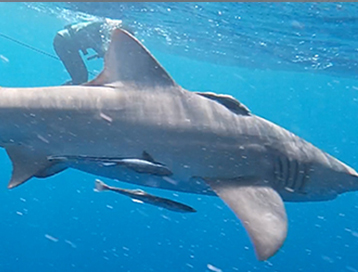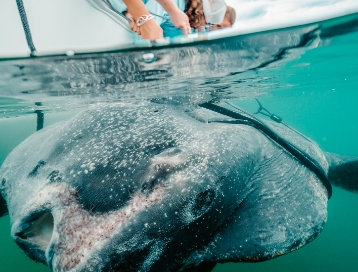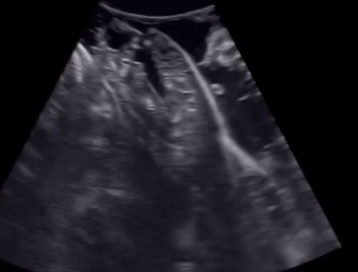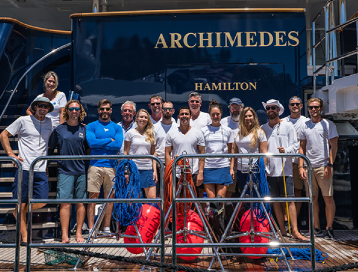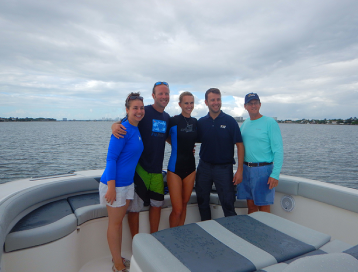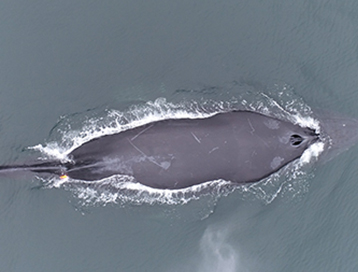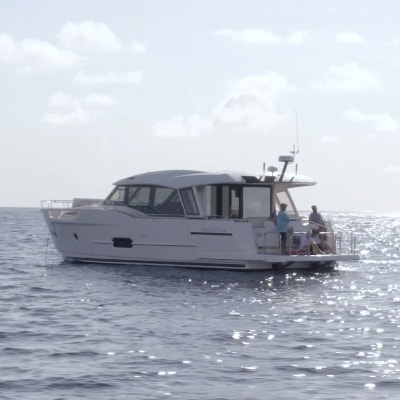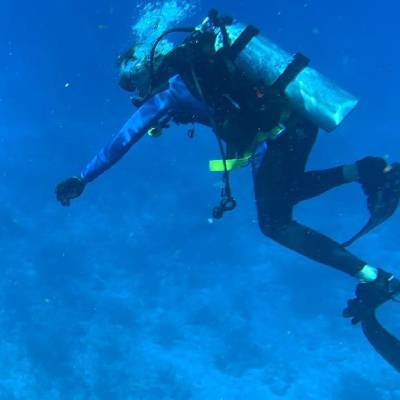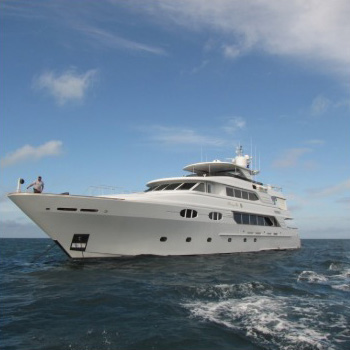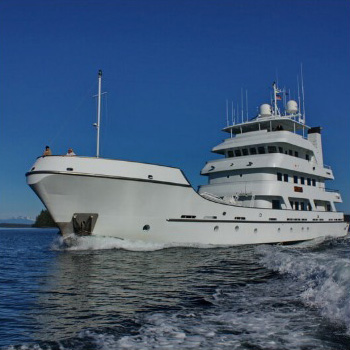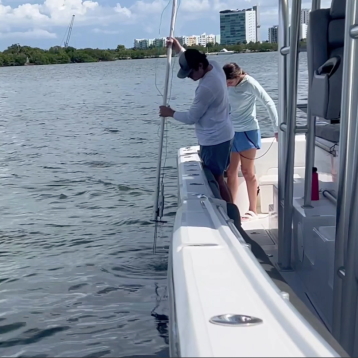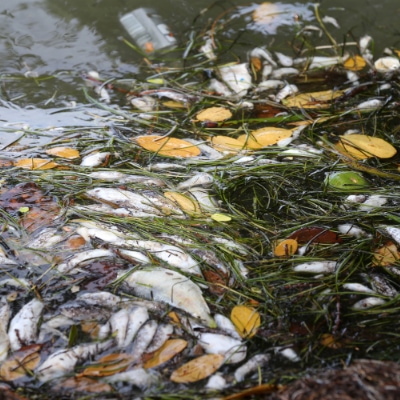The International SeaKeepers Society has been involved in assisting significant research and conservation efforts through the DISCOVERY Yacht Program since 2014. While the organization has engaged in more than 180+ expeditions since that time, the following are a selection of expeditions that demonstrate the impact of our partnerships. A complete list of programming coverage on Scientist-led Expeditions and Citizen Science activities is also chronicled by date individually.
Overview
The International SeaKeepers Society has helped facilitate several pelagic fish research projects since 2014, including rare and illusive species like mola mola, permit, and various shark species. Many SeaKeepers sampling expeditions have targeted shark species, which are tagged using either satellite tags, which track movement from satellites in space, or acoustic tags, which track movements from underwater “listening stations.” Physiological data is also collected, often consisting of body measurements and conditions, muscle tissue samples, blood samples, and small fin tissue samples. In other cases, observational video data from BRUVs (baited remote underwater video) or other remote sensing technology is used to determine the presence and prevalence of certain species in a particular location in both shallow and deep waters. In one specific instance, a new technology, the Birth Tag, was developed and deployed for the first time to detect exactly where and when sharks may give birth.
Impact
Marine fish research has broad implications for the health of our oceans because large fish species, especially apex predators like sharks, are keystone species for ecosystems. This means if these species are removed, the biological balance of the local and even global ecosystem is impacted. Not only are large marine fish species like sharks vital for balance in marine systems, but their healthy populations in coastal habitats like coral reefs, kelp forests, and seagrass meadows also support human health and global economies through food production, medicine, and ecotourism. It’s for that reason that we place tags on various large marine fish species to learn where they are going, if they have residency in one particular location, how they reproduce, and more! Learning about marine species whereabouts also provides data needed to establish more marine-protected areas, fisheries regulations, and other policy changes to limit the exploitation of marine ecosystems. Marine fish research like that done alongside SeaKeepers is paramount to helping conserve and protect some of the most important (and most misunderstood) inhabitants of our oceans.
The research we’ve helped facilitate has helped answer questions about where marine fish are migrating and whether they are impacted by the creation of designated marine protected areas. Research has even, in some cases, shown where exactly certain species are spawning or giving birth, which is crucial to understanding the vulnerability of juveniles and breeding adults for their protection. This, in turn, brings to light the fact that we share our coastal environments with large marine fish species more than we realize, and that an ocean full of healthy fish populations is essential to ocean life.
VESSEL ENGAGEMENT:
- DISCOVERY Yacht Shredder
- DISCOVERY Yacht Mystique
- DISCOVERY Yacht M’Powered
- DISCOVERY Yacht Penny Mae
- DISCOVERY Yacht Little Penny
- DISCOVERY Yacht Qing
- DISCOVERY Yacht Fugitive
- DISCOVERY Yacht Nouvurania
- DISCOVERY Yacht BG3
Since 2014, SeaKeepers has provided 14 vessels to cover activities related to international shark research, which has assisted three universities and one marine science non-profit in furthering their research.
Overview
A Paul G. Allen initiative led by researchers at Florida International University, Global FinPrint has united researchers and collaborators from around the world to study sharks, rays and other marine life on coral reefs using baited remote underwater video systems (BRUVS) surveys - assessing coral reef sharks and rays on a global scale for the first time.
Impact
Why is the research meaningful? What does it address as an application to real-world problems?
Recent estimates suggest that around 100 million sharks are taken each year for their fins and meat; many species have suffered severe declines due to unregulated fishing.
Although you may have heard about “finning” - the removal of fins from live sharks, with the sharks then being discarded at sea to die - you might be surprised that shark fishermen in most nations use the whole shark: fins, skins, cartilage, jaws, meat and all. The real problem is that without careful controls on how many are taken, this can exceed the ability of many shark species to replenish fished populations.
One-quarter of sharks and their relatives are threatened with extinction, according to the IUCN Red List of Threatened Species. Loss of these predators threatens the food security of nations that rely on fish for human consumption and threatens the dive tourism industry that relies on sharks as living attractions.
Their absence can also disrupt the balance of marine food webs, causing large-scale habitat changes.
- The data will be the foundation of a global, open-access shark and ray survey database that can be used to prioritize research needs and conservation actions.
- Researchers, NGOs and policymakers will be able to use these data to improve conservation plans and raise awareness of the ecological importance of sharks and rays.
- Global FinPrint will assess the effectiveness of existing approaches for shark and ray conservation; identify new hotspots of shark and ray abundance that should be considered for protection; and establish the ecological role of sharks and rays in coral reef ecosystems in order to help justify conservation investments.
What application has the research produced in any meaningful progress in the area it’s focused on?
Global FinPrint’s first global analysis, published in Nature, found that sharks were absent on nearly 20 percent of the reefs surveyed. Reef sharks were largely absent in several nations that exhibited high human population density and poor governance of marine resources, highlighting the importance of working with local people and governments to address root social and economic causes of overfishing. Opportunities for reef shark conservation remain in most places: National shark fishing bans ("Shark Sanctuaries"), fishing regulations, no-take marine protected areas and other approaches are being used successfully in different parts of the world to prevent reef shark extinctions. We are working with local researchers and resource managers to implement fishing regulations, protected areas and trade controls based on our findings. We also identified locations where reef sharks are still common that could seed the recovery of populations in other locations if conservation measures are implemented.
VESSEL ENGAGEMENT:
For the duration of the Global FinPrint Project, SeaKeepers provided three vessels to aid in underwater video data collection.
Overview
The International SeaKeepers Society has helped facilitate several marine mammal/cetacean research projects since 2014. This included utilizing suction-cup tags attached to whales to determine the kinematics of maneuvers. These tags have cameras as well as several other types of sensors that can sense the acceleration, orientation, and rate of rotation of a tagged whale. Overall, these observations help gather data to answer questions about how these animals move and use energy when foraging and feeding. In other cases, observational data was taken to assess populations of certain species in specific locations. In one specific instance, the vocalizations of humpback whales were recorded and played back to observe the whales’ responses. This eventually can help develop mathematical models which will help decode non-human intelligence and communication – not only here on earth, but perhaps one day from space.
Impact
Why is the research meaningful? What does it address as an application to real-world problems?
The continued recovery of whales and other cetaceans may help to stabilize marine ecosystems. This recovered role may be especially important as climate change threatens ocean ecosystems with rising temperatures and acidification.
Baleen and sperm whales, known collectively as the “great whales,” include the largest animals to have ever lived on Earth. With huge metabolic demands, they eat many fish and invertebrates and distribute nutrients through the water column and ocean. Even their carcasses, dropping to the seafloor, provide habitat for many species that only exist on these "whale falls." Commercial whaling dramatically reduced the biomass and abundance of great whales.
As we learn more about their important role in the ecosystem, we will be better equipped to solve or prevent certain ecological problems. Additionally, learning more about how these intelligent animals communicate can help us better understand other non-human intelligent communication so that we’ll be better equipped to recognize and understand other non-human intelligent communication.
What application has the research produced in any meaningful progress in the area it’s focused on?
The research and fieldwork facilitated by the DISCOVERY Yacht Program has allowed renowned scientists well into their careers to training a number of undergraduate and graduate students on cetacean research methods, including radio tracking, photo ID, drone operations, and survey protocols.
The use of drones/UAS from SeaKeepers platforms has been used in four scientific publications do date. The data that was collected allowed scientists to make precise measurements of blue and humpback whales in Monterey Bay to determine length and body condition. Aerial drone video footage was collected on the maneuverability of these species and how they use their flippers and flukes to conduct acrobatic maneuvers while feeding. This work has supported a number of graduate theses and dissertations at UC Santa Cruz, Stanford, and Duke University.
VESSEL ENGAGEMENT:
Since 2014, SeaKeepers has provided three vessels to aid in Whale/Cetacean research.
Overview
The International SeaKeepers Society has helped facilitate several coral reef research projects since 2012. This included expeditions where hundreds of samples were collected from the Florida Reef Tract, as well as video observations to survey fish assemblages and coral health just offshore of Fort Lauderdale, FL. Overall, these observations help gather data to answer questions about how well corals and other reef habitats are possibly adapting to changing ocean conditions, if at all. These conditions include warming temperatures and acidification. Other threats to corals and reefs might be the mishandling of dredge material during the creation of man-made ports and harbors such as Port Everglades and the Port of Miami, burying and stifling existing coral reefs.
Impact
Why is the research meaningful? What does it address as an application to real-world problems? Corals and the reefs that are made up of coral colonies are immensely important parts of our ecosystems. They provide food and habitat for smaller fish, crustaceans, and other forms of marine life. If reefs go, so does marine life as we know it. Learning more about the vulnerabilities and resiliencies of these sedentary animals is paramount to the overall health of the ocean. If certain coral species and genotypes can genetically adapt to warming temperatures, the plan, would be to spread these favorable heat tolerant genes to other colonies. Also, If burying coral reefs does in fact affect them, with very little regrowth, then it would be imperative that the disposal of dredged material be better regulated in future dredging projects.
What application has the research produced in any meaningful progress in the area it’s focused on? The findings of the ongoing project to assess the health of buried reefs off of Port Everglades have been included in Ph.D. theses, sparking the careers of future marine scientists. What is most compelling for the future of coral reefs is that it was found that corals can pass on the genes for heat tolerance. Some coral genotypes are more tolerant than others, but immigration of these more tolerant corals into less tolerant populations can spread this favorable trait. In a world where CO2 emissions are still quite prominent and can only be reduced at a glacial pace, there is hope in knowing that we can help protect and restore coral populations by actively transferring genes and encouraging their evolution.
VESSEL ENGAGEMENT:
List any other vessels that devoted time & resources to the project/subject matter if they were not included in the above three expedition profiles.
- D/Y Miss Phebe
- D/Y Vigilante
- D/Y Lady Olivia
- D/Y Shredder
- D/Y Marcato
- D/Y Isabel
- D/Y Cabrillo
- D/Y Sea Hag
- D/Y Surface Interval
- D/Y Santosha
- SK/V DISCOVERY
- D/Y Sauerkraut
Since 2012, SeaKeepers has provided 15 vessels to cover activities related to coral reef research, which has assisted three universities and one non-profit in furthering their research.
Overview
The International SeaKeepers Society has helped facilitate several genomics and DNA research projects since 2012. In one expedition, a state-of-the-art mobile biomedical laboratory created by Florida Biodiversity Institute was placed onboard a yacht, which facilitated real-time, remote genome scale sequencing in a pioneering week-long research expedition. Another expedition researchers dove on Andros and Nassau reefs to identify existing sponge species and collect sponge, sediment and water samples. Samples were brought back to laboratories at NSU for further analysis and genetics work. Further expeditions conducted the first ever gathering of surface and subsurface plankton across the North Pacific specifically for genomic sequencing.
Impact
Why is the research meaningful? What does it address as an application to real-world problems? Understanding how multiple genes work together to make increasingly complex memories is a building block toward better understanding brain disease. Most interestingly, is that certain invertebrates can regenerate their rudimentary brains and neurons. Learning more about how this is done, can possibly help in seeing if this can be done with humans. Additionally, the tiny, planktonic organisms, such as copepods, salps, ctenophores, and juvenile cephalopods that were collected during these expeditions, are integral members of marine ecosystems and play a vital role in the health of our oceans. By collecting samples and sequencing planktonic genomics, we are able to learn more about these critical species by identifying and tracking them to assess their connectivity and dispersal.
What application has the research produced in any meaningful progress in the area it’s focused on? Several papers have been published using data gathered on expedition facilitated by SeaKeepers. These initial findings are the steppingstones to broader applications that can come from genomics research.
VESSEL ENGAGEMENT:
List any other vessels that devoted time & resources to the project/subject matter if they were not included in the above three expedition profiles.
- D/Y Harle
- D/Y Vigilante
- D/Y Mystique
Since 2014, SeaKeepers has provided 6 vessels to cover activities related to genomics research, which has assisted three universities in furthering their research.
Overview
In the summer of 2020, northern Biscayne Bay became inhospitable for several species of fish and marine life, leaving the coast completely covered with dead fish. Researchers immediately sought to find out what could have caused this massive fish die-off, and more importantly, how may we be able to anticipate and prevent it in the future. Since 2020, we have facilitated sampling of the area to assess dissolved oxygen levels, nutrients, salinity, pH, temperature, and any other parameters that can help us better understand the cause of these fish kills.
Impact
Why is the research meaningful? What does it address as an application to real-world problems? The ultimate hope is that this data and trends over time will help predict another hypoxia event. Biscayne Bay is a shallow estuary. It is a place where freshwater from the mainland mixes with salt water from the sea. The bay serves as a nursery for marine life. Seagrass beds provide hiding places as well as food for a vast array of sea life. Many fish, crustaceans and shellfish spend a portion of their lives in the protective environment of the bay. Additionally, seagrass beds have been shown to be very effective at sequestering carbon from the atmosphere. Seagrass has also shown signs of die-off in recent years. Hypoxia and toxicity are just two indicators (another being harmful algal blooms) that the overall health of the Bay is at risk and needs to be protected by whatever means necessary.
What application has the research produced in any meaningful progress in the area it’s focused on? So far, the research has answered some questions about how rising termperatures, especially in the summer months, can be a significant factor in the hypoxic events plaguing the Bay. Additionally, and intriguingly, it has brought up new questions; one being, are sulfide levels in the sediment, due to lack of dissolved oxygen, also creating a toxic environment, meaning that even more factors need to be considered when assessing the health of Biscayne Bay.
VESSEL ENGAGEMENT:
List any other vessels that devoted time & resources to the project/subject matter if they were not included in the above three expedition profiles.
- D/Y Phantom
Since 2020, SeaKeepers has provided 3 vessels to cover activities related to Biscayne Bay fish kill research, which has assisted 2 universities and one non-profit organization in furthering their research.


